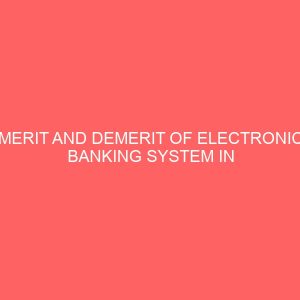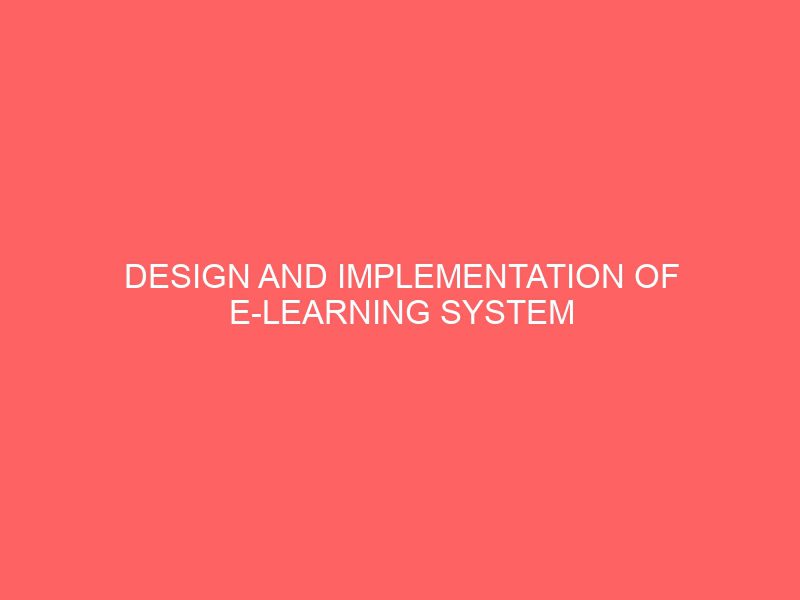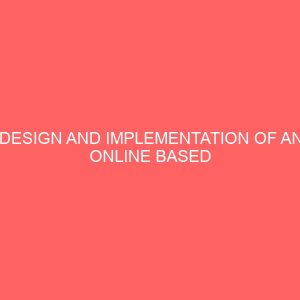CHAPTER ONE
This project is on design and implementation of e-learning system. E-learning refers to electronic learning, it is the acquisition of knowledge and skill using electronic technologies such as computer and internet based courseware and local and wide area networks.
Distance learning is one of the most dramatic technology-based changes occurring in education today. Communication technology enables learners to receive instruction despite geographic and time disparities that would make traditional classroom instruction impossible.
Distance instruction is learner-centered—that is, it enables learners to tailor the instruction that they are receiving to meet their individual needs. Some distance programs use print media, some use telecommunications, and many use both, but geographic and time separation of the student and the teacher is a fundamental characteristic of distance education. Multimedia instruction with networked computers, video systems, or television may be used to connect the local classroom to learners at a distance. Satellite, compressed video, and fiber-optic systems are increasingly used for same-time, different-place education. This approach is also called synchronous distance learning. Students can also learn at different times and in different places. This approach is called asynchronous distance learning.
1.1 BACKGROUND OF STUDY
Early e-learning systems, based on Computer Based Learning/Training often attempted to replicate autocratic teaching styles whereby the role of the e-learning system was assumed to be for transferring knowledge, as opposed to systems developed later based on Computer Supported Collaborative Learning (CSCL), which encouraged the shared development of knowledge.
As early as 1993, Graziadei William described an online computer-delivered lecture, tutorial and assessment project using electronic mail, two VAX Notes conferences and Gopher/Lynx together with several software programs that allowed students and instructor to create a Virtual Instructional Classroom Environment in Science (VICES) in Research, Education, Service & Teaching (REST). In 1997 Graziadei, W. et al, published an article entitled Building Asynchronous and Synchronous Teaching-Learning Environments: Exploring a Course/Classroom Management System Solution. They described a process at the State University of New York (SUNY) of evaluating products and developing an overall strategy for technology-based course development and management in teaching-learning. The product(s) had to be easy to use and maintain, portable, replicable, scalable, and immediately affordable, and they had to have a high probability of success with long-term cost-effectiveness. Today many technologies can be, and are, used in e-learning, from blogs to collaborative software, e-Portfolios, and virtual classrooms. Most e-learning situations use combinations of these techniques.
Looking around students especially tertiary education suffers a lot of setbacks in external exams due to the primitive nature of teaching system which they receive. They don’t have access to global information hence lacks a huge knowledge of what is obtainable in the society, the library is not equipped with good books and at the same time they don’t have access to internet.
The rate of examination malpractice has increased and attention must be given fast to it before it ruins the education system of the country.
Also, distance is a barrier to some people who seek to be educated.
1.3 OBJECTIVES OF THE STUDY
- To provide alternative way of attaining education
- To implement a system which reduces examination malpractices
- To facilitate the development of information technology
- To enhance examination and certification of students thereby improving
the standard of education.
- To reveal the use and technology of wireless network to the user.
1.4 SIGNIFICANCE OF THE STUDY
E-learning can provide benefits for the organizations and individuals involved.
Improved performance: it is interactive to the students thereby improving their productivity.
Improves standard of education: it eliminates examination inadequacies like examination malpractices.
Increased access: it enables people from any part of the world to be educated.
Convenience and flexibility to learners: learning process is structured in units; this makes the learner study at his own convenience without getting too bored with lectures.
Reduced cost: it reduces the cost of learning, examination and result processing institutions.
1.5 SCOPE OF THE PROJECT
This project is a tutorial and measurement of performance on wireless network technology. The project is designed using PHP and MySQL.
1.6 LIMITATIONS
Due to financial constrains, people cannot afford this form of learning and measurement, especially towards the cost of accessing the internet.
Also, the rate of technology is moving at rapid speed and not everybody understands how some of the tools used for this education process are used.
1.7 DEFINITION OF TERMS
E-Learning: learning conducted via electronic media, especially via the Internet.
World Wide Web: World Wide Wed simply called www is the most important tool of the Internet.
Web Site: A website is a collection of many interconnected web pages organized by a specific college, organization company etc, containing web pages (good and commodities) on the Internet.
Hyperlinks: Hyperlinks are highlighted words and phrase you find on web documents that you can click on as to jump to some other documents or Internet services.








Reviews
There are no reviews yet.